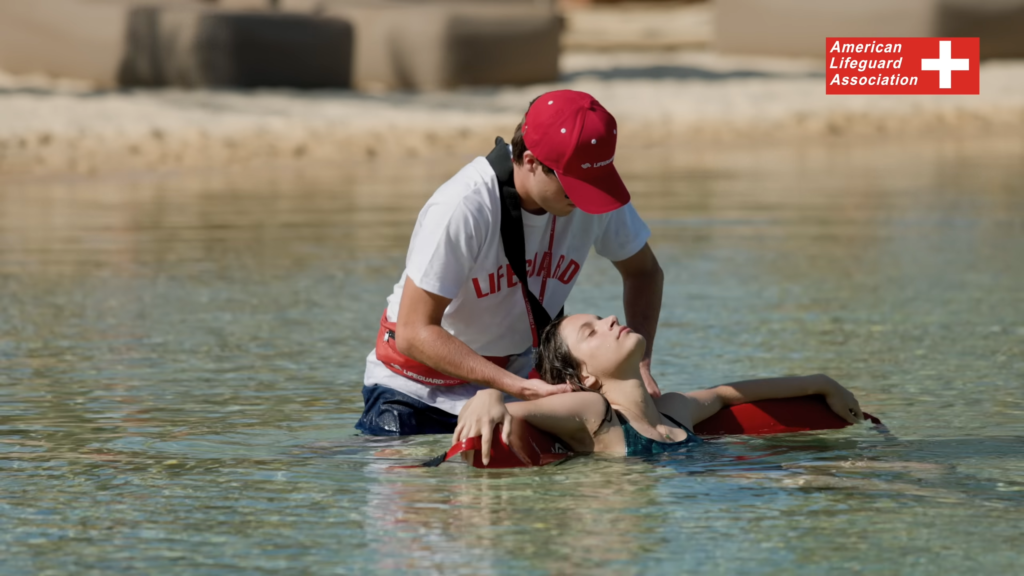Lifeguard and safety training teaches people how to save lives in the water. Lifeguards watch over pools, beaches, and lakes to keep swimmers safe. They learn how to rescue people, give CPR, and use first aid if someone gets hurt. Being a lifeguard isn’t just about swimming. It’s about being strong, fast, and ready to help in emergencies. With the right training, lifeguards prevent accidents and protect lives. At American Lifeguard USA, we teach the skills needed to become a certified lifeguard, making sure every lifeguard is prepared for real-life rescues. Lifeguarding is a serious job.
Essential Skills for Lifeguards
Lifeguards need more than just strong swimming skills. They must be ready to act fast and think clearly in emergencies. One of the most important skills is water rescue techniques. Lifeguards learn different ways to save swimmers in trouble, whether they are struggling in deep water or caught in a strong current. They practice using rescue tubes, reaching assists, and even diving for submerged victims.
Another crucial skill is CPR and first aid. Lifeguards must know how to help someone who has stopped breathing or is injured. They learn how to perform chest compressions, use an automated external defibrillator (AED), and treat wounds, burns, or broken bones. Quick action can mean the difference between life and death.
Communication and teamwork are just as important. Lifeguards work in teams, so they must communicate clearly with each other and with swimmers. They use whistles, hand signals, and radios to give instructions and call for help. Being calm and confident during an emergency helps everyone stay safe.
Finally, lifeguards need mental strength and quick decision-making. They must assess dangerous situations, choose the best rescue method, and react within seconds. Training helps lifeguards stay focused under pressure so they can save lives without hesitation. At American Lifeguard USA, we make sure lifeguards develop these critical skills to keep swimmers safe in any situation.
Lifeguard Certification Process
Becoming a lifeguard requires proper certification to ensure lifeguards are fully prepared for emergencies. The process starts with lifeguard training classes, where students learn swimming skills, rescue techniques, CPR, and first aid. These classes are led by certified instructors and include both classroom learning and hands-on practice in the water.
After training, students must pass a swimming skills test. This often includes swimming a certain distance without stopping, retrieving a weight from deep water, and treading water for several minutes. These tests prove that lifeguards have the endurance and strength needed for real-life rescues.
Next, students take a written exam and a practical skills test. The written exam checks their knowledge of rescue techniques, safety rules, and emergency procedures. The practical test requires them to demonstrate lifesaving skills, such as performing CPR, using rescue equipment, and responding to different emergency scenarios.
Once they pass all the tests, lifeguards receive a lifeguard certification from an accredited organization like American Lifeguard USA. This certification is usually valid for two years before recertification is required.
Lifeguard training isn’t just a one-time event. lifeguards must stay updated on new safety techniques and renew their certification regularly. By completing the American Lifeguard USA certification program, lifeguards ensure they are always ready to protect lives in any aquatic environment.
Physical and Mental Fitness for Lifeguards
Lifeguarding is a physically demanding job, requiring strength, endurance, and mental focus. A lifeguard must be able to swim long distances, tread water for extended periods, and carry people out of the water. To stay in top shape, lifeguards follow a fitness routine that includes swimming laps, strength training, and cardiovascular exercises like running or cycling. Strong muscles and good stamina allow lifeguards to perform rescues quickly and effectively.
Beyond physical fitness, mental toughness is just as important. Lifeguards must stay calm under pressure, make fast decisions, and remain alert for long shifts. Training includes mental preparedness exercises, such as stress management techniques and focus drills. A lifeguard who panics in an emergency could put both themselves and the victim at risk.
Another key aspect of mental fitness is situational awareness. Lifeguards must constantly scan the water, identify potential dangers, and predict when an accident might happen. This requires sharp concentration and quick thinking.
At American Lifeguard USA, we emphasize both physical and mental readiness in our training programs. Lifeguards don’t just train to be strong swimmers. They train to be lifesaving professionals who can handle any challenge with confidence and skill. Whether at a pool, beach, or water park, a well-trained lifeguard is the key to keeping swimmers safe.
Advanced Lifeguard Training
Basic lifeguard training prepares lifeguards for common emergencies, but advanced training takes their skills to the next level. This specialized training is essential for lifeguards working in challenging environments like open water, deep pools, or high-risk aquatic parks.
One key aspect of advanced training is deep-water and open-water rescue techniques. Rescuing a swimmer in deep or moving water requires extra strength and skill. Lifeguards practice reaching panicked victims safely, using rescue boards, and handling rescues in strong currents or waves. Ocean lifeguards must also learn about tides, rip currents, and marine life hazards.
Another advanced skill is spinal injury management. If a swimmer suffers a head, neck, or spinal injury, lifeguards must know how to stabilize the victim in the water without causing further harm. They practice using backboards and teamwork techniques to ensure safe extractions.
Lifeguards also train in rescue equipment handling, such as oxygen tanks, resuscitation masks, and personal flotation devices. Using the right equipment correctly can mean the difference between life and death.
At American Lifeguard USA, we offer advanced training for lifeguards looking to enhance their skills and prepare for more demanding rescue situations. Whether working at a wave pool, a deep-water facility, or an oceanfront beach, lifeguards must always be ready for the toughest rescues.
Safety Protocols for Aquatic Facilities
Lifeguards do more than just save lives. They also prevent accidents before they happen. Every aquatic facility, whether a pool, beach, or water park, follows strict safety protocols to keep swimmers safe. Lifeguards are responsible for enforcing these rules and ensuring that everyone follows proper water safety guidelines.
One of the most important protocols is drowning prevention. Lifeguards must scan the water constantly to spot struggling swimmers early. They also enforce pool rules, such as no running, no diving in shallow areas, and no rough play. These rules may seem simple, but they prevent serious injuries and drowning risks.
Another critical safety measure is managing hazardous situations. This includes handling chemical spills in pools, dealing with extreme weather at outdoor facilities, and responding to unexpected emergencies like power outages or equipment malfunctions. Lifeguards must know evacuation plans and how to keep the public calm in emergencies.
In addition to monitoring swimmers, lifeguards maintain rescue equipment to ensure it’s always ready for use. They check first aid kits, rescue tubes, and defibrillators regularly.
At American Lifeguard USA, we train lifeguards not only to respond to emergencies but also to prevent them. A well-trained lifeguard is the first line of defense in making sure every aquatic environment remains a safe place for fun and recreation.
First Aid, CPR, and AED Training for Lifeguards
Lifeguards are often the first responders in an emergency, making first aid, CPR, and AED training essential to their job. These lifesaving skills allow lifeguards to help injured or unconscious swimmers until professional medical help arrives.
CPR (Cardiopulmonary Resuscitation) is one of the most important skills lifeguards must master. If someone stops breathing or their heart stops beating, immediate CPR can save their life. Lifeguards learn how to perform chest compressions and rescue breaths on adults, children, and infants.
Another key skill is AED (Automated External Defibrillator) usage. An AED is a device that helps restart a person’s heart using controlled electric shocks. Lifeguards are trained to quickly set up and operate an AED, which can be critical in cases of cardiac arrest.
First aid training covers a wide range of injuries, including cuts, burns, broken bones, and heat exhaustion. Lifeguards must know how to control bleeding, bandage wounds, and handle medical emergencies like seizures or allergic reactions.
At American Lifeguard USA, we ensure that all lifeguards are fully trained in first aid, CPR, and AED use, giving them the knowledge and confidence to act fast in an emergency. These skills don’t just save lives in the water. They can be used anywhere, making lifeguards valuable members of their communities.
Lifeguard and Safety Instructor Training
Becoming a lifeguard is just the beginning. Those who want to teach and lead can take the next step by becoming a lifeguard instructor. Instructors are responsible for training new lifeguards, teaching water rescue techniques, and certifying students in CPR, first aid, and AED use.
To become an instructor, lifeguards must complete an Instructor Certification Course, which includes advanced rescue techniques, teaching strategies, and evaluation methods. Instructors learn how to lead training sessions, conduct skill assessments, and ensure students meet certification standards. Strong communication and leadership skills are essential, as instructors must be able to guide students through both classroom learning and hands-on practice.
Instructors also stay up to date on new safety protocols and advancements in lifeguard training. They play a key role in maintaining high safety standards at pools, beaches, and water parks. Certified lifeguard instructors can work at aquatic facilities, community centers, and training organizations like American Lifeguard USA.
At American Lifeguard USA, we offer comprehensive instructor training for experienced lifeguards who want to mentor the next generation of lifesavers. By becoming an instructor, lifeguards don’t just save lives. They help train others to do the same, making a lasting impact on water safety.
Legal Responsibilities and Ethics in Lifeguarding
Lifeguards have a legal and ethical duty to protect swimmers and follow strict safety regulations. Their duty of care means they must always be alert, prepared, and ready to respond to emergencies. If a lifeguard fails to act properly, they can be held legally responsible for any injuries or accidents that occur.
One of the most important legal responsibilities is proper documentation and reporting. Lifeguards must keep records of incidents, injuries, and rescues. These reports help facilities improve safety protocols and protect lifeguards from liability.
Lifeguards also follow a strict code of ethics. They must treat all swimmers with respect, enforce rules fairly, and never abuse their authority. They must also prioritize safety over everything else, making sure they are always focused while on duty.
At American Lifeguard USA, we train lifeguards to understand their legal responsibilities and ethical duties, ensuring they act professionally at all times. A lifeguard’s job isn’t just about rescuing people. It’s about being a responsible leader in water safety.
Lifeguard Training Near Me – Finding the Best Programs
If you’re looking for lifeguard training near you, it’s important to choose a program that offers comprehensive training, experienced instructors, and official certification. Not all training programs are the same, so it’s essential to find one that meets high safety standards.
The best lifeguard courses include hands-on water training, CPR and first aid certification, and real-world rescue simulations. They should also be taught by certified instructors who have experience in lifeguarding and emergency response.
At American Lifeguard USA, we offer top-quality lifeguard training programs across the country. Our courses provide expert instruction, practical experience, and nationally recognized certification. Whether you’re a beginner looking to get certified or a lifeguard needing recertification, we have a program to fit your needs.
By choosing American Lifeguard USA, you’re ensuring that you receive the best training possible. Giving you the skills and confidence to save lives and make a difference.
Conclusion: Ensuring Water Safety Through Proper Training
Lifeguarding is more than just a job. It’s a commitment to protecting lives. Through proper training in rescue techniques, first aid, and safety protocols, lifeguards become the first line of defense against water emergencies. They must be physically strong, mentally sharp, and always ready to respond.
At American Lifeguard USA, we are dedicated to training the best lifeguards and instructors, ensuring that pools, beaches, and water parks remain safe for everyone. By choosing professional lifeguard training, you’re not just learning skills. You’re becoming a lifesaver.



